
Things You Can Do To Save Gas

There is a consistent, dizzying pattern emerging: When gas prices top $4 a gallon, Americans get religion about fuel economy. The value of big SUVs drops and Honda Civics get second looks. With $5 gallon gas in some states, the process is well underway.
As of late March, regular gas has gone up 47% in price in the last year, to an average of $4.24. Premium gas is up 41%. Diesel is up the most in the past year, 62%. Diesel is similar to home heating oil and jet fuel.
The pattern has been that when the pain at the pumps subsided—even a little—consumers go right back to their big SUVs. Now, with credible EVs and hybrids on the market, things may be changing permanently.
Buy Regular Fuel
There’s no need for premium gas unless your automaker specifically demands it with labels “premium only” or “premium required” (not just “preferred”) on the gas gauge or fuel filler door. Typically, the car will run fine on regular with no damage to the engine. Using regular in a premium-preferred car may cost a half-second accelerating to 60 mph. Premium costs an extra 67 cents a gallon (16%) at late March prices. Automakers say gas of any grade labeled Top Tier has all the detergent additives needed to keep their engines clean.
Combine Trips
In the morning, you realize you need butter, so you hop in the Bulgemobile and go get it—three miles out, three back—then go again in the afternoon when the milk is running out. How about waiting until the shopping list attains critical mass—five items or more? As fueleconomy.gov tells us, “Several short trips taken from a cold start can use twice as much fuel as a longer, multipurpose trip covering the same distance.”
(Don’t) Carry That Weight
Adding 100 pounds lowers fuel economy by 2%. The junk in the trunk—golf clubs from last summer, the overdue library books, the Goodwill donations that never make it to the bin—add up.
Don’t Speed
Fueleconomy.gov reports, “Speeding increases fuel consumption and decreases fuel economy as a result of tire rolling resistance and air resistance. While vehicles reach optimal fuel economy at different speeds, gas mileage “usually decreases rapidly at speeds above 50 miles per hour.” Reducing speed 5 to 10 mph returns 7% to 14% better mileage.
